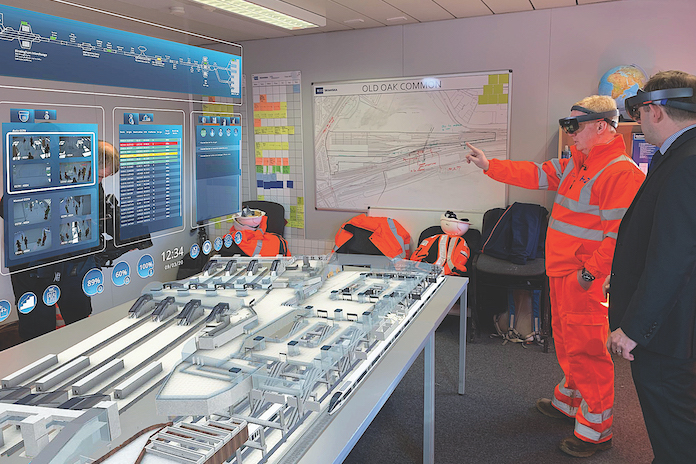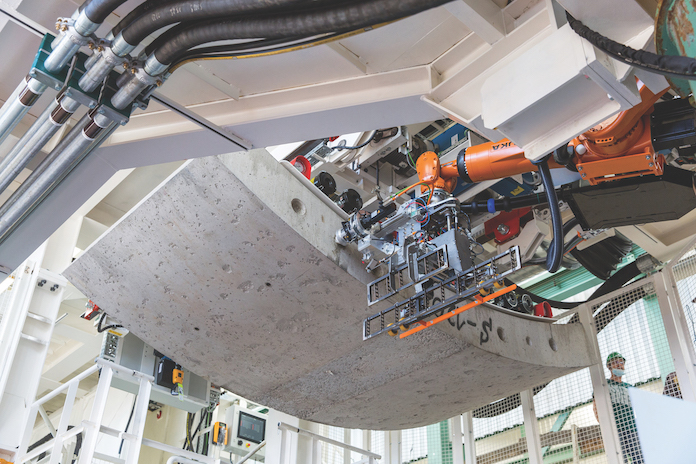
Image credit: Dreamstime
The UK’s biggest infrastructure project is a hotbed of innovation which could transform the wider industry. CM finds out more from head of digital engineering Dr Sonia Zahiroddiny
Whatever the detractors might think of its very concept, HS2 is an ambitious project – and digital engineering is at the heart of it.
The project’s numbers are dizzying: 343 miles of railway track, 45 miles of tunnels, 37 miles of viaducts, 119 miles of cutting, 120 miles of embankment and 30,000 people working on it.
Among them is Dr Sonia Zahiroddiny. As HS2 Ltd’s head of digital engineering, it’s her task to drive BIM and related technologies through the project. Whatever legacies the mega-project leaves behind when complete, the demonstration of the benefits that digital engineering can bring will be to the fore.
“It is one of our ambitions to make sure we can leave that legacy. Professor Andrew McNaughton, who at the time was our technical director, used to say that BIM is the lifeblood of HS2. And it has truly been seen that way from day one,” she states with evident passion.
“But since then the thinking has matured, and we have rebranded the terminology, or the way that BIM is perceived, to become more than just 3D modelling, to become digital engineering. And the thinking is still maturing and is still evolving.”
Zahiroddiny describes many digital developments being introduced on HS2 as “fairly alien” to the sector.
“It’s effectively a change programme, and with any change programme, there can be huge cultural and, in some cases, commercial barriers to overcome,” she explains.
“We find that people engage when they see the value of digital or BIM, or how the wider digital landscape can add to their day-to-day jobs. To bring people into the [digital] fold, you’ve got to make sure the messaging is simple. They’re interested in knowing ‘how does this make my job easier’?
“We’ve drawn up use cases, case studies and personas to try to put context around digital engineering. So if I’m a project manager, what is [digital engineering] to me? By adopting a wider change approach, combined with upskilling, we’re hoping that we can overcome some of those barriers.”

HS2 CEO Mark Thurston visits the Old Oak Common station site using an augmented reality headset
HS2’s digital engineering upskilling platform, originally unveiled in 2016, was given a fresh launch with further resources in October 2020.
It provides free-to-access e-learning and resources to the supply chain. There were 11 e-learning courses available as CM went to press, ranging from developing a BIM execution plan, via BIM documentation and roles and responsibilities, to understanding HS2’s information delivery cycle. The platform also includes a jargon buster.
Zahiroddiny adds: “The platform clarifies our strategy and targets, our implementation methods and what that means to contractors.
“The portal is an engaging and innovative learning platform, and we will continue to update it with more courses. There is an appetite out there for people to want to improve or increase their digital maturity.”
She is proud of HS2’s visualisation hub, describing it as “the first of its kind, a unique platform, which has never been used on previous major projects”. The hub was designed by a consortium led by PCSG, the digital built environment consultancy recently bought by Bentley Systems.
“The visualisation hub brings our vision for a virtual railway to life, and will form the basis of our digital twin,” Zahiroddiny says.
“With the scale and the complexity of HS2, we are producing huge amounts of data – millions of records, terabytes of data. And currently these various data sets are coming from our contractors in various formats, and are stored, managed and interrogated in a number of very specialist systems across the organisation.
“Ultimately the visualisation hub is a web-based platform that acts as a ‘top hat’. It’s basically an integration platform that brings all of these data sets together, and thus provides us with multiple views of the railway as it’s being planned and designed and constructed. And it really helps us to remove some of the complexity we’re currently facing in accessing and analysing some of this data.”
She continues: “The hub is the convergence of GIS and 3D modelling, CAD, BIM and asset information, because it brings all of these various elements together. But it also pulls in some of the project controls data (cost data and some of the health and safety incident data), and, once we have our data-streaming platform stood up, some of the telemetric data as well.
“The hub should, by default, make it simpler and quicker to find the data, to understand the situation or context of the data. So you can look for an asset, know where it’s located, see all the graphical representations of it, see all the related documentation, see how much we forecasted, and see how much the actual spend is.
“It just makes it much easier for you to view, interrogate and analyse the data in a single, unified platform.”

Dr Sonia Zahiroddiny, HS2
Zahiroddiny reports that HS2’s digital strategy is already delivering tangible benefits.
“Our contractors are already reporting that the use of 5D modelling and quantity take-offs have increased consistency and standardised the process of creation of design,” she says. “And this has resulted in increased productivity: they’re reporting a reduction in man hours of up to 50% to 60% across their stages of the programme.
“Another example is extensive use of 4D modelling in construction sequencing. Close integration with the project controls team has enabled improved visual identification of areas of risk, allowing us to mitigate some of these risks before we start construction – and that’s resulted in roughly 40 days of time savings.”
She thinks there’s a two-way exchange of intelligence and experience happening between HS2 and its tier 1 contractors: “There’s collaboration and innovative thinking both ways: they’re responding to our requirements, but at the same time, they’re coming back and saying ‘we can go over and above’, or ‘this is what we can do’, or ‘these are some of the benefits we are seeing’. It has been a joint effort.”
Included in that joint effort is Zahiroddiny’s 20-plus team: a team with a mixture of both construction and non-construction backgrounds.
She explains: “I’m not an engineer by profession myself – I come from a computer sciences background. The team come from learning and development, or psychology, or data architecture and data sciences: these are all the sorts of skills that you don’t typically associate with digital engineering or rail infrastructure more broadly. But within the CAD and GIS areas, the majority of them have been within the rail sector for a while.”
Warming to her theme, she adds: “I’ve really tried to look outwards and say: ‘Look, if you’re really going to push beyond the mandate and become more digitally enabled, then that goes beyond just the 3D models – they’re just nice 3D pictures, and there’s a lot more involved.
“And therefore it does require a broad sets of skills – for example, enterprise architects, or data architects or process managers who understand how to do process mapping who will help us re-engineer some of the old-school ways of doing things. So the fresh perspective that this diverse range of people have brought in is a fresh eye on things, and they have been rightly challenging some of the ways we have been doing things.”
Aside from the visualisation hub and the upskilling platform, she emphasises her team’s greatest success: “Raising the profile around the importance of data and digital: that’s been a huge undertaking. And it’s been driven both bottom up and top down.”
Digital engineering, she adds, will also be key to how HS2 is operated after construction is completed.
“With the digital twin, we’re not only going to have this holistic view of the railway, to validate and verify that it meets all of our requirements and that we can operate it, but we’re also leaving something for our end-user, the state operator, to take and run with,” she says.
Five digital innovations keeping HS2 on track

The Krokodyl robot in action
1. On board robots for TBMs
The Bouygues, Sir Robert McAlpine and VolkerFitzpatrick JV has developed an on-board robot for tunnel boring machines (TBMs). The Krokodyl robot will carry out repetitive tasks such as removing wooden spacers between tunnel segments on the 16km-long Chiltern tunnels.
2. 4D learning tech for safety
The Balfour Beatty Vinci JV is using immersive technology from 3D Repo to improve site safety. The technology, cloud-based SafetiBase 4D, sees workers enter a 360-degree virtual version of a site where they can identify safety issues.
3. AI-enabled estimating
An AI-enabled carbon and cost estimating tool is being trialled by the Skanska Costain Strabag JV. It automates BIM processes so that different design options can be simulated using different types and quantities of construction materials.
4. IoT sensors in cement mixers
Tech startup Cloud Cycle’s IoT solution uses sensors fitted inside cement mixers to monitor the quality of the concrete mix. Shortlisted for HS2’s Innovation Accelerator programme, Cloud Cycle estimates it could reduce concrete used on phase one by up to 420,000 tonnes.
5. Drones for tree-planting
Another firm picked for Innovation Accelerator backing is Dendra, which has created a drone and AI platform to plant and monitor the 140-mile green corridor along the route. The system learns how to identify the 46 tree species planted and monitor their health.









